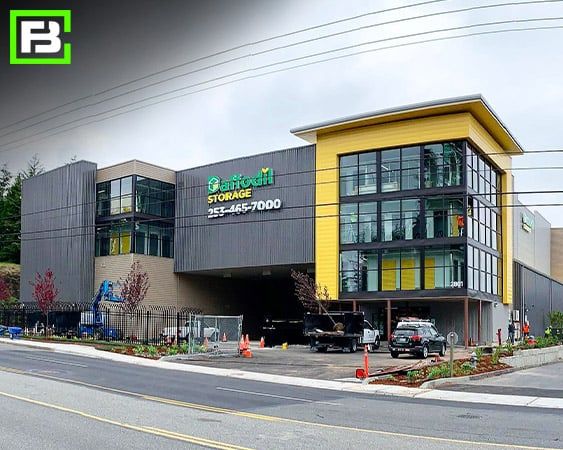 National Self Storage Builders have experienced record growth over the past two years. Self Storage industry growth has been driven by major life-altering events such as divorce, death, disaster, and dislocation. Beyond these traditional demand drivers, the pandemic added new factors to the equation. Shifts to remote work and relocations and the need for businesses to store goods and supplies locally have been major demand drivers across the sector.
National Self Storage Builders have experienced record growth over the past two years. Self Storage industry growth has been driven by major life-altering events such as divorce, death, disaster, and dislocation. Beyond these traditional demand drivers, the pandemic added new factors to the equation. Shifts to remote work and relocations and the need for businesses to store goods and supplies locally have been major demand drivers across the sector.
As a result, the sector recorded a substantial uptick in both occupancy and rental rates across the U.S. Self-storage rents reached historical highs in 2021, and experts are optimistic that this sector will continue to perform well this year, according to the latest National Self Storage Monthly Report from Yardi® Matrix.
As the year progresses, most operators are seeing uncharacteristically high occupancy rates, giving them the possibility to maintain and ultimately increase street rates, according to this same Yardi Matrix report.
The national street rates for a 10×10 non-climate-controlled units grew 6.7% on a year-over-year basis in December 2021, while rates for 10×10 climate-controlled units increased 7.4%, down 80 basis points from the gains recorded in the previous month. Despite cooling rents, the growth rates are well above of where they were in December 2020, when national increases were 2.3% for 10×10 non-climate-controlled and 3.5% for climate-controlled units.
Overall, no metros in the top 30 markets tracked by 3rd party analytical groups recorded negative rate performance on a year-over-year basis. A total of 22 markets saw 5 percent or higher rent growth in the non-climate-controlled category and 19 markets registered the same growth in the climate-controlled category.
Nonetheless, on a month-over-month basis in January, national rates for 10×10 non-climate-controlled units declined by $1 to $127, and rates for the same-size climate-controlled units also fell $1 for the third consecutive month to $145.
While some short-term demand drivers have dissipated, the long-term need for storage space is bolstered by several demographic trends, including Millennial family formation, downsizing retirees, and accelerated migration across the U.S.
The pandemic also urged many people to leave expensive urban centers in favor of suburban areas and smaller, lower-cost cities. This migration trend will likely persist in 2022, benefiting the storage sector.
Although self-storage rents are coming off record-high gains seen in 2021, industry experts expect robust growth in 2022. Most operators will start the spring leasing season on a high note, with strong occupancy rates, giving them the possibility to maintain and ultimately increase street rates.
Nationally, projects under construction or in the planning stages accounted for 8.9% of total stock, up 10 basis points over the previous month. The number of storage facilities under construction increased by 24 to 719, while the number of planned projects dropped by four to 1,252. Overall, there were 3,022 self-storage properties in various stages of development as of December 2021.
New York continues to have the most robust pipeline, with projects under construction or in the planning stages equal to 19% of total inventory, up 40 basis points over November. Las Vegas was second on the list—the metro’s new-supply pipeline increased from 15% in November to 15.6% in December 2021.
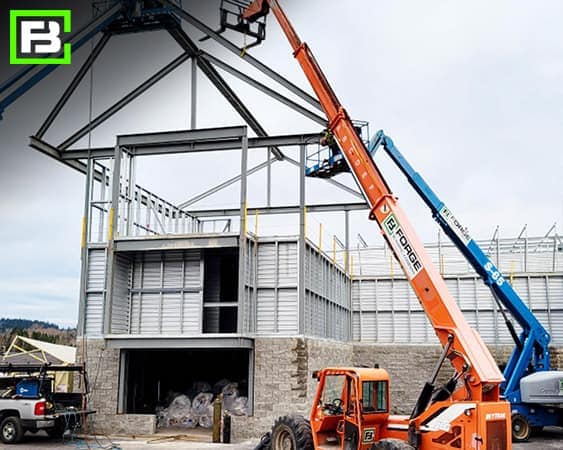 Although industry experts expect occupancy and rental rates to slightly moderate this year, the shift in the way people live and work will likely continue to foster a competitive environment for the self-storage sector in 2022. And due to healthy market fundamentals, investor interest is also set to remain high.
Although industry experts expect occupancy and rental rates to slightly moderate this year, the shift in the way people live and work will likely continue to foster a competitive environment for the self-storage sector in 2022. And due to healthy market fundamentals, investor interest is also set to remain high.
All in all, thanks to the record-setting performance over 2021, the self-storage sector is set for another strong year.
If you’re looking to invest in a self-storage project, Forge Building Company would love to help. We partner with top-notch investors and developers nationwide. With over 15 years of experience in this space, we will provide all the necessary information needed for your project to be a success from start to finish.
Here is how we can help.
Forge knows self-storage and has built over 60 million square feet of it. Let’s begin the discussion on your next project. To obtain a quote request, click Request a Quote.
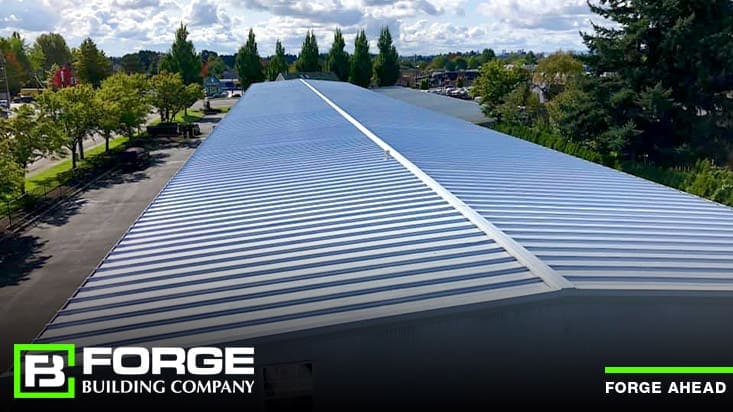
Building a self-storage facility that looks great is important, but to keep customers happy and business booming, you also need to ensure your facility is maintained…especially your unit doors and roof.
One of the most distinguishing factors of a self-storage facility are the roll-up doors, so it’s important that they be well-maintained! Not only do they contribute to curb appeal, but they are a large part of the tenant experience and can be a safety hazard if left untended.
Doors should be inspected before a tenant moves in, and again after they’ve moved out. Inspection of a roll-up door doesn’t just mean ensuring it looks good but also means it is functioning properly. Here are some guidelines for ensuring your doors look good and function properly.
Even when your self-storage units are occupied, there are aspects of your doors that should be inspected regularly. (O'Hearn, 2022) For example, examine the curtain for damage and check the latch for tampering. If the unit has a header draft stop or jamb brush seal, determine if they have excessive wear and replace them if necessary.
Once a unit becomes vacant, there are other items you should inspect before renting it to the next customer.
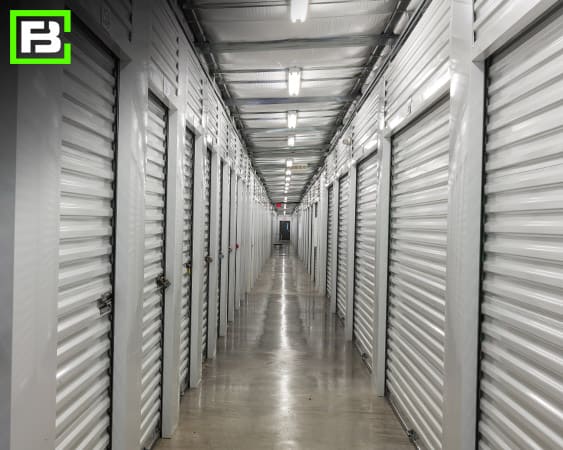 The most common adjustment to your self-storage doors as they age will be to spring tension. When properly tensioned, the door will open easily. Once it’s about two-thirds open, it should roll up the rest of the way on its own. The springs need more tension if they close too rapidly or require significant force to open. Most doors have a ratcheting mechanism that allows you to make necessary adjustments.
The most common adjustment to your self-storage doors as they age will be to spring tension. When properly tensioned, the door will open easily. Once it’s about two-thirds open, it should roll up the rest of the way on its own. The springs need more tension if they close too rapidly or require significant force to open. Most doors have a ratcheting mechanism that allows you to make necessary adjustments.
If you’re in an area that requires wind-locked doors, inspect the brackets and confirm they’re secured to the door. If they are not secure, drill out the old rivets and put in new ones. Some door guides come with a wind-lock insert; ensure they’re also secured now.
Protecting your tenant’s property is the main focus of a self-storage facility. That protection includes the structure of the building, and a big part of that structure is the metal roof. It doesn’t matter if you have a traditional, single-story facility or a multi story facility – your metal roof matters.
As self-storage buildings age, roof maintenance and repair become more important and time-consuming. An inspection and maintenance program are an important part of sustaining roof life as well as keeping costly repairs and property claims in check.
With proper inspection and maintenance, a metal roof can last for decades. A good program aims to proactively locate and repair possible leaks while extending the life of the metal panels.
This inspection and care will help you keep your roof in the best possible condition. The most effective examination for metal-roof systems includes four specific areas: the perimeter, the ridge, fasteners, and debris.
To learn more, see Forge Building Company - Metal Building Re-Roofing with Standing Seam Metal Roof Panels
Perimeter inspections are simple and quick. (Ness, 2015)
The ridge is another area for potential leaks.
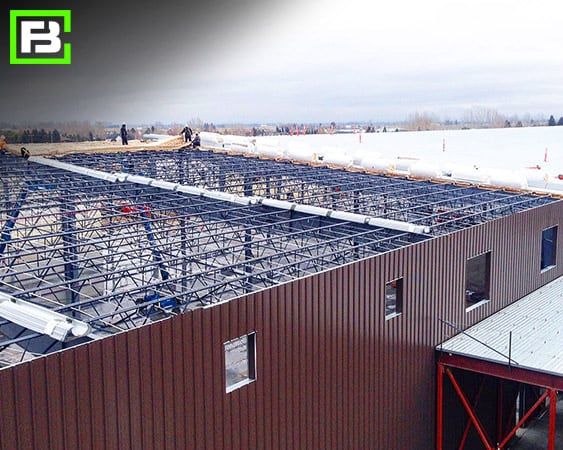 Effective fastener inspection requires walking each fastener row, one at a time. Fasteners are the single biggest maintenance concern on the older (built in the last 10-20 years) R-panel roof systems. R-Panel roofing has exposed fasteners every few feet. This becomes an issue when the metal roof expands and contracts with hot and cold weather, as the fasteners can become loose. This is where leaks can begin. Not only do loose fasteners allow water into the units, but they can also cause rust and mold. In these screw down roof types, sometimes the seals or seams are not sealed correctly, which can also lead to rust and leakage at your facility. The options are to remove and replace the fastener with a new one or apply non-silicone sealant to the top of the fastener, making certain to completely encapsulate the head.
Effective fastener inspection requires walking each fastener row, one at a time. Fasteners are the single biggest maintenance concern on the older (built in the last 10-20 years) R-panel roof systems. R-Panel roofing has exposed fasteners every few feet. This becomes an issue when the metal roof expands and contracts with hot and cold weather, as the fasteners can become loose. This is where leaks can begin. Not only do loose fasteners allow water into the units, but they can also cause rust and mold. In these screw down roof types, sometimes the seals or seams are not sealed correctly, which can also lead to rust and leakage at your facility. The options are to remove and replace the fastener with a new one or apply non-silicone sealant to the top of the fastener, making certain to completely encapsulate the head.
Standing Seam metal roofing has now replaced R-Panel as an industry standard roof for a few reasons. To start, Standing Seam roofs are 24 gauge, whereas most R-Panels are 26-29 gauge. This means that Standing Seam roof panels are made of thicker metal and are therefore stronger than other panel types. Standing Seam roofs are more resistant to leaks, and this is mostly due to the way that they are designed and installed. This means no water damage to a tenant’s property, which is always a plus.
Debris on the roof can clog gutters as well as damage metal panels. Certain metal items can strip the Galvalume coating from the panels and dramatically shorten their life. Wire hangers and batteries are two of the biggest culprits, and the end result can be a large area of rust. The longer the metal item is on the roof, the greater the damage will be.
In the self-storage industry, limited access to units makes leak identification a difficult task. Vacant units should be inspected by the manager immediately following a significant rain. This gives the manager the opportunity to find unreported leaks and can help alleviate problems from tenants in the future. When a leak is identified, it is always advisable to make or arrange repairs as soon as possible.
We all know the customer experience is the backbone of any successful business. At Forge Building Company, we partner with developers that provide the best doors and roofs in the industry. We have over 15 years of experience in this space and will provide all the necessary information needed to help maintain and grow your business.
Let’s begin the discussion on how we can help. Click Contact Us to connect!
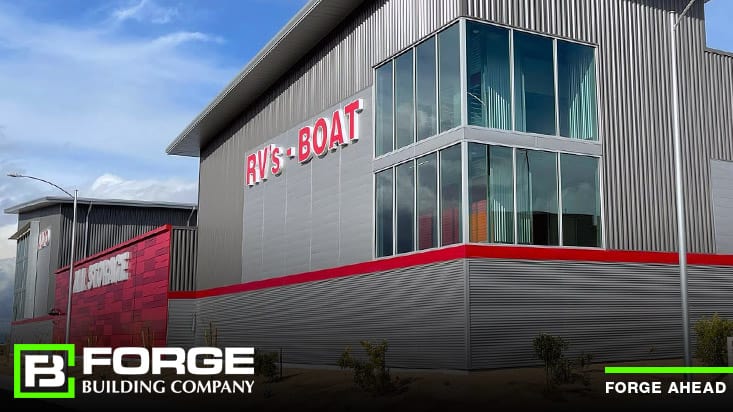
As a self-storage owner/manager, your approach to customer service can make the difference between securing a rental or losing a customer to a competitor. However, in today’s environment, self-storage tenants demand even more. To win them over, you must create the ultimate customer experience.
Prospects visiting your property are generally there for one of a few very specific reasons: to rent a unit, buy packing supplies, pay a bill, or discuss a rental-related issue. Your job is to make these tasks as easy as possible by removing barriers, obstacles, and complications. Therefore, your service approach is vital.
Customer service is all about the interactions you and your employees have with potential and current tenants in person, over the phone, and via e-mail, text, or other online channels. It always involves human interaction. The customer experience includes every way and place a person interacts with your business, even when there’s no person involved.
Today, the customer experience requires more wow factor thanks to an evolving market filled with creative websites, social media, online reviews, mobile apps, and other technology (see our recent blog, “Technology – What You Need for Your Self-Storage Business”). The self-storage customer experience consists of everything from finding and renting a unit online to entering the gate to opening the unit door. There are many opportunities for it to go right, and as many opportunities for it to go wrong.
The following are easy ways to elevate the customer experience and better connect with prospects and tenants, which can help you grow your business.
It’s absolutely imperative that any customer-facing staff properly represent your self-storage operation. The right facility manager must be enthusiastic, energetic, and integrity. He/she must have a positive, can-do attitude and a customer-centric mindset.
A friendly face goes a long way in customer service. Warmly greet your current and potential customers when they contact you to make a great first impression and solidify a reputation for positivity with each interaction.
If a prospect shows up at the front door, come running. Make sure you’re always accessible, no matter where you may be on the property. If a customer knows you’re dropping everything to help him/her, he’ll appreciate the level of service you provide.
First impressions are vitally important, so greet everyone with a smile and kind words. Here are some other things you can do:
 Every customer has a preference for communication. Your customer service should offer several lines of communication, including email, texts, online chats, and phone service, so anyone can get in touch the way they feel most comfortable. A willingness to meet lessees halfway is a valuable trait for any customer service team.
Every customer has a preference for communication. Your customer service should offer several lines of communication, including email, texts, online chats, and phone service, so anyone can get in touch the way they feel most comfortable. A willingness to meet lessees halfway is a valuable trait for any customer service team.
Having a personal connection with you directly at their local facility will bolster customers’ confidence in your business. Customers appreciate businesses treating them like real people rather than numbers, adding to their bottom line. Take the time to learn your customers’ names and a little about them. If your customers feel at home, they’ll keep coming back Additional tips to consider:
Be open to not only phone calls and in-store visits but to emails and other forms of communication. Customers may send questions or requests via text, Facebook Messenger, Instagram, Snapchat, or similar platforms. If you aren’t prepared to engage in online chat with them, but your competitor is, guess who will win the rental? Additional tips to consider:
Stay in touch with existing customers as well as prospects and former tenants. In times of uncertainty, it’s especially important to be reassuring. Thank them for their business and let them know you’re thinking of them, without trying to sell them anything.
Give tenants the option to opt-in for text messages. Send e-mails containing news, announcements, and other important information. Don’t hassle or upsell; just tell them about the necessary stuff like holiday office hours, discount coupons for loyal tenants, and digital copies of lease and insurance documents.
Additional tips to consider:
Review your facility as a whole. Your company needs a logo and color scheme that’s universal from store to website to social media platforms to print materials. Your business name should be consistent everywhere it appears. If you rebranded an existing facility, look for any places where the old name and logo still exist, as this will confuse customers. Keep your logo and colors uniform so people always know they’re in the right place.
One of the biggest assets for a positive customer experience is your website. Your website should be easy to find and use. If images take several seconds to load or your platform isn’t mobile-friendly, it will have a negative effect on prospects and customers.
Content for your web presence is the single most important thing for search engine optimization and for prospects and customers to be able to quickly find your business. This includes your blog posts, social media, landing pages, FAQ pages, video, and everything else that relates to your business and lives online.
Other helpful technology that will improve the customer experience includes any automation you use, security and access tools, digital signage, and property-management software that facilitates online rentals and autopay. Remember, customers expect technology that’s easy to use, available around the clock, nice to look at, and engaging.
 Creating a positive customer experience starts by listening attentively. This means thoroughly absorbing, understanding, responding, and retaining what is being said. While sales are central to any business, listening to a prospect’s specific needs and providing customized solutions is paramount for gaining and retaining a customer.
Creating a positive customer experience starts by listening attentively. This means thoroughly absorbing, understanding, responding, and retaining what is being said. While sales are central to any business, listening to a prospect’s specific needs and providing customized solutions is paramount for gaining and retaining a customer.
Practice asking questions that will give you more marketing insights and improve the customer experience, such as:
The reason a customer chooses or needs to store his belongings isn’t always pleasant. It could be caused by circumstances such as divorce, job loss, eviction, or the death of a loved one. While offering sympathy might be the first, instinctive response, being empathetic is what will stick in a tenant’s mind long after the moment. Try to remember what it’s like to experience a break-up; what it would feel like if your spouse lost his job, or a grandparent passed away.
Does your facility offer coffee and tea, or chilled water for customers? How about free Wi-Fi to help them while they’re between houses (and internet providers)? Other value-added services could include:
One of the ultimate ways to create the ultimate customer experience is to put yourself in the customer’s shoes. Is your company easy to find online and what information is available? Is your website easy to read and use? Is all content up to date? Walk through the experience of renting a unit, visiting the site, and accessing the unit. Was anything surprising? Confusing? Alarming? Go about this drill as if you’re someone who knows nothing about the industry and see how easy it is to navigate the process of looking for, renting, and using self-storage.
The connection you make with customers by using these strategies and how you fulfill their needs are ultimately what will make your customers' experience pleasant and help with retention and referrals in the future.

As many people fled to new cities during the pandemic, they kept their stuff in self-storage facilities. Thus, the global self-storage development pipeline has continued to be extremely dynamic.
That being said, many states have enacted new self storage industry laws and regulations from employment to rental contracts that went into place on January 1, 2022.
For example, Senate Bill 101 (SB 101) was signed into law, which will allow self-storage operators to advertise lien sales on online-auction websites instead of in a newspaper of general circulation. The measure also updates rental-agreement requirements regarding delinquency notifications. Many other states have followed suit.
Self-storage rental agreements now must request that tenants provide two email addresses and a mobile number. Facility operators must also inform customers, either within the rental agreement or via verified mail, of the company’s right to enforce a lien. If this information is included in the lease, it must be in bold type at least 12 points in size, and the customer must initial next to the language when signing. If delivered by mail, the information must also be sent via email and text message.
When notifying delinquent tenants of an active lien, self-storage operators must send written notices via verified mail to the last known physical address on the rental agreement as well as by email (primary and secondary addresses) and text message, if provided on the lease.
Operators can still advertise a lien sale 10 days after notification is mailed to the tenant or at least 10 days after the payment deadline has passed, whichever is later. Though that timeframe didn’t change in the updated law, operators must wait 30 days to begin lien enforcement if the notice of lien rights was sent to the tenant via mail instead of included and acknowledged in the rental agreement.
The national Self Storage Association (SSA) recommended that all operators update their rental contract. The bill was supported by the SSA and the Louisiana Self Storge Association, which lobbied to eliminate the newspaper-advertising requirement.
 Keeping current with employment laws is challenging but critical for all business owners. Self-storage operations, like all other businesses, have an obligation to comply with state and federal laws that apply to the hiring, work, and termination of employees. Lawsuits are filed every day against owners who believe they’re acting properly in regard to their staff, only to find out certain laws have changed, and they failed to update their systems accordingly. Following are six important areas you should review to ensure you’re current with employment legislation.
Keeping current with employment laws is challenging but critical for all business owners. Self-storage operations, like all other businesses, have an obligation to comply with state and federal laws that apply to the hiring, work, and termination of employees. Lawsuits are filed every day against owners who believe they’re acting properly in regard to their staff, only to find out certain laws have changed, and they failed to update their systems accordingly. Following are six important areas you should review to ensure you’re current with employment legislation.
The federal minimum wage was recently raised for the first time since 2009. As a result, many states have taken steps to increase their own minimum-wage requirements, causing uncertainty for multi-state self-storage operators as to the proper wage for employees. It’s essential to confirm you’re paying above the minimum at each facility location.
More than 27 states have increased their minimum wage since 2014. Many of those states have even created an “index” for annual inflation, thereby increasing the wage automatically each year over the next few years. In addition, more than 44 localities (cities and counties) have increased minimum wage above the state minimum.
One of the most difficult issues for self-storage owners is exemption. Many pay their facility managers an hourly wage rather than an annual salary. This means staff are non-exempt and must be paid for overtime. In general, they’re entitled to time and a half for hours over 40 worked per week. You must know your wage requirements for the states in which you operate and track your staff hours to ensure proper compensation.
An ongoing challenge in the self-storage industry is how to address hours worked by managers who live on site. Although the practice of hiring of resident managers is diminishing, there are still properties with manager apartments.
The initial idea behind resident management was to offer customers (and owners) a sense of security and a higher level of service. But with the “live where you work” approach comes the risk that employers and employees have a different understanding of “work hours.” This issue isn’t unique to self-storage and has been addressed by the U.S. Department of Labor (DOL). It also arises with apartment managers, firefighters, and other positions in which the employee resides at the workplace.
The DOL has relied on the law found in the Code of Federal Regulations (CFR), specifically 29 CFR 785.23, titled “Employees residing on employer's premises or working at home.” Based on this rule, storage owners can set guidelines with their employees to hopefully avoid any later dispute over hours to be worked and work to be performed.
Under the U.S. Immigration Reform Act, all employers must have a valid and complete Form I-9, Employment Eligibility Verification, for each employee, citizen or noncitizen. The employee must attest to and provide proof of his identity, though the documentation to prove it can vary. There’s a list of acceptable documents on the form, and an employer can’t limit what he’ll accept as proof.
Employees must complete their I-9 no later than their first day of work. Employers must complete their part of the form no later than the employee’s third day of work. They must then retain all forms until the later of three years after the employee began work or one year after he was terminated. The documents can be stored electronically and needn’t be kept in the original format.
An employer can be found to have violated immigration laws if he fails to verify the identity and eligibility of a new employee through the use of an I-9. Fines for violations, depending on the number of employees involved, can range into tens of thousands of dollars, especially for those who knowingly fail to obtain the forms as required. Criminal prosecution is also possible for repeat and flagrant offenders. U.S. Immigration and Customs Enforcement can consider its penalties based on the size of the business, the good faith effort to comply, the seriousness of the violation, whether the violation involved undocumented workers, and the history of previous violations.
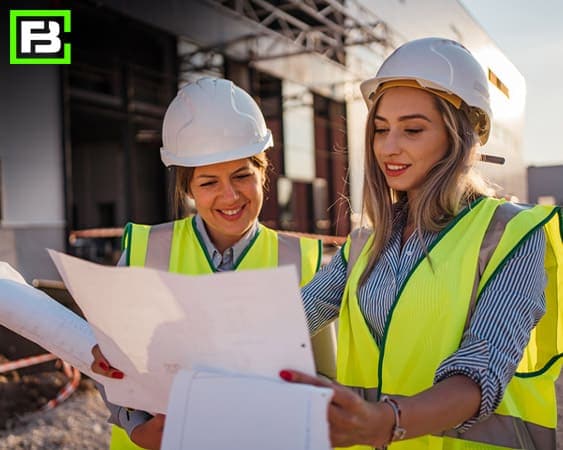 Unique changes in employment laws in California, Illinois and New York provide guidance as to women’s rights in the workplace. In New York City, all employers with 15 or more employees in are required to conduct annual anti-sexual-harassment training for all staff. Similarly, California has amended its state law to require all employers with more than five employees to provide anti-harassment training to staff, with additional training for all supervisors.
Unique changes in employment laws in California, Illinois and New York provide guidance as to women’s rights in the workplace. In New York City, all employers with 15 or more employees in are required to conduct annual anti-sexual-harassment training for all staff. Similarly, California has amended its state law to require all employers with more than five employees to provide anti-harassment training to staff, with additional training for all supervisors.
Additionally, the California law was amended to disallow any settlement agreements that would prohibit the disclosure of the underlying sexual-harassment claim. In other words, the law would void any agreement where a person was required to forfeit his rights to disclose the unlawful acts that occurred in the workplace.
At Forge, we are happy to be employing many women executives who are spearheading the industry movement in the world of construction. For our position on this topic, see women in construction
Sexual harassment is a form of sex discrimination as outlined under Title VII of the Civil Rights Act of 1964. There are two recognized forms. The first is a type of “quid pro quo” scenario in which a supervisor demands a subordinate tolerate harassment as a condition of keeping his job (or tenancy). The second is the existence of a hostile or abusive work environment where conduct can be verbal or physical, is frequent, and is improperly tolerated.
From a legal perspective, the discussion should be about workplace education and training as well as proper procedures for reporting claims and managing the investigation and discipline regarding such claims. The business liability exposure is such that the company as well as the perpetrator can be liable, depending on what the company knew about the conduct and what it did to stop the harassment.
Companies must have a sexual-harassment policy in place, no matter their size. Though only companies with 15 or more employees are subject to the federal laws for Title VII claims, smaller companies may still be held liable under applicable state laws. There must be sufficient training related to sexual harassment, so employees can be educated about proper behavior in the workplace as well as the procedures in place in case an incident occurs.
Two recent topics have led business operators to update their employee handbooks. The first is the use of social media; the second is driving while using a cellphone.
Employers are subject to potential liability if their employees, acting under the scope of their employment, post negative social media statements against other employees, customers, or the company itself. Certainly, employers can be even held liable if their employees, to impact competition, post false or fake reviews to impact business. To combat these risks, employers should update their policy handbooks to address employee behavior on social media. These policies should outline how staff are to conduct themselves online and the risk of discipline and possible termination for the violation of these rules.
Similarly, employers can be held liable for injuries that arise as a result of the employee’s violation of the law while driving and using a mobile phone during working hours. Now that more states have enacted “hands-free” laws, an employee must understand the applicable laws and recognize they’re subject to discipline if not termination for any infractions while driving within the scope of work (visiting customers, running facility errands, etc.).
One of the trickiest arts of running a self-storage business is having staff. Today, self-storage owners need to pay attention not only to federal laws, but also to the states and municipalities laws where the business resides. As a self-storage owner, it’s imperative to stay informed on these ever-changing regulations. Liability can be significant in terms of cost to defend and financial exposure to the business.
At Forge, we stay abreast of all state and federal regulations to ensure that our clients get the best-quality, compliant self-storage facilities in their area. For more information on how we can help you, please see Forge Building Company

At Forge, we understand that construction doesn’t come to a halt when winter weather hits, so it’s important to know the steps to take to keep workers warm and safe. According to the most recent data published by the Bureau of Labor Services, in recent years upward of 20,460 workplace injuries were caused by snow, sleet, or ice. So, before the next major winter storm starts to impact your area with snow and ice accumulation, be prepared and review these winter weather safety tips for construction workers.
When winter weather strikes, Supervisors should:
The last thing any company would want is to have a construction site full of workers stranded because a blizzard blew in without warning. During the winter, it is key to keep an eye on the forecasts in order to give workers adequate time to secure the construction site and get home safely before any severe weather strikes.
During the winter months, it is important to have a reliable way to communicate with workers, especially those in remote areas, during storms and extreme weather to ensure all are accounted for in case of evacuation or schedule changes.
Consider enacting a buddy system, assigning at least two workers together in cold, remote locations and maximize jobsite safety by preparing for a flexible schedule. Weather changes quickly, so can your project in response.
 As temperatures continue to plummet, keep a careful watch on workers for signs of hypothermia and frostbite. Make sure workers are wearing appropriate clothing for the weather and encourage them to take frequent breaks to warm up from the cold.
As temperatures continue to plummet, keep a careful watch on workers for signs of hypothermia and frostbite. Make sure workers are wearing appropriate clothing for the weather and encourage them to take frequent breaks to warm up from the cold.
It is also super important to check workers for signs of fatigue, frostbite, or hypothermia.
Cold stress occurs when the body is unable to warm itself and can lead to hypothermia and frostbite. Hypothermia occurs when the core body temperature falls below 95°F. Common symptoms include shivering, shallow breathing, confusion, loss of coordination, drowsiness, slurred speech, and slow, weak pulse.
If someone is showing symptoms of hypothermia, it is imperative to get their core temperature back up. Remove all wet clothing and move the person to a dry, warm area. Use blankets, additional clothing, and heating pads to increase their temperature.
If conscious, they should be given warm liquids to drink. CPR should be given immediately to an unconscious hypothermic person or one who has no pulse or isn’t breathing, and 911 should be called for emergency medical service.
Frostbite occurs when body tissue freezes and is most common in the extremities since these areas tend to have less blood flow when exposed to cold temperatures. Color changes in the affected tissue and loss of normal sensation are typical signs of frostbite.
Rewarm frostbitten areas with warm water. Avoid rubbing the areas to warm it up and do not use heating pads to try and warm the affected areas. Call 911 and get medical treatment immediately if affected by frostbite.
Finally, remind workers to limit consumption of caffeine, nicotine, and other stimulants as this increases their heart rate, causing them to feel warmer than they actually are.
Construction workers tend to expend more energy when working in cold weather in order to keep their bodies warm. It is key to ensure the company has a heated trailer, tent, or indoor area for workers to warm up from the cold. Limit exposure to the elements by encouraging workers to take frequent breaks in order to rest and warm up, drink warm liquids, and change out of wet clothing.
If using portable heaters in break areas, make sure to vent the area properly and use CO sensors to monitor for carbon monoxide exposure.
During the winter months, it is important to take extra steps in ensuring workers are wearing the proper clothing and gear as well as all necessary personal protective equipment (PPE) when winter weather conditions are present.
 Follow the manufacturer’s instructions on properly warming up heavy equipment before use.
Follow the manufacturer’s instructions on properly warming up heavy equipment before use.
Keeping warm is one of the most important things when working in cold weather. The key is finding a balance of wearing enough layers to stay warm while still being able to maintain a good range of mobility to perform the required work.
For more tips on keeping warm on the construction site, be sure to check out 10 Tips for Keeping Warm on the Construction Site.
Make sure each of your company’s fleet of work trucks and vehicles is equipped with winter weather emergency kits. Kits should include a:
Encourage workers to create emergency kits for their personal vehicles.
Remind workers to be cautious when driving in snow and ice, giving themselves plenty of time to get to their destination, and leaving plenty of space between themselves and other vehicles to avoid accidents.
Keeping construction workers safe is always a top priority with The Forge Team!

The self-storage industry has proven to be fairly recession-proof during the pandemic and offers many diverse investment opportunities and strategies depending on the location, according to a report from Trepp.
The report, titled “Self-Storage: Analyzing a ‘Recession-Resistant’ Sector,” looks at commercial mortgage-backed securities (CMBS) data. According to Trepp’s CMBS database, more than 1,700 CMBS loans totaling almost $16 billion were backed by self-storage properties across the US. It is one of the smaller property types in the private-label CMBS universe of over half a trillion dollars of loans, accounting for only 3% of the total CMBS outstanding balance.
The reason an individual would rent a storage unit is being driven by what the report refers to as the four Ds of self-storage: divorce, dislocation, death, and downsizing. Of course, there has been an abundance of these throughout the pandemic.
In addition, there were a number of trends that directly impacted the demand in the self-storage sector.
Another big factor contributing to this industry’s resilience are its net operating income margins which are among the highest of any real estate asset type at upwards of 60% to 70%, Trepp says, citing a Cushman & Wakefield report.
Those attributes have attracted a wide variety of players, including the five largest real estate investment trusts (REITs) that together own about 20% of the market:
That leaves thousands of other owners and other investors that have driven construction spending up by 584% from January 2015 to January 2020, the Trepp report says, citing census data on self-storage facilities.
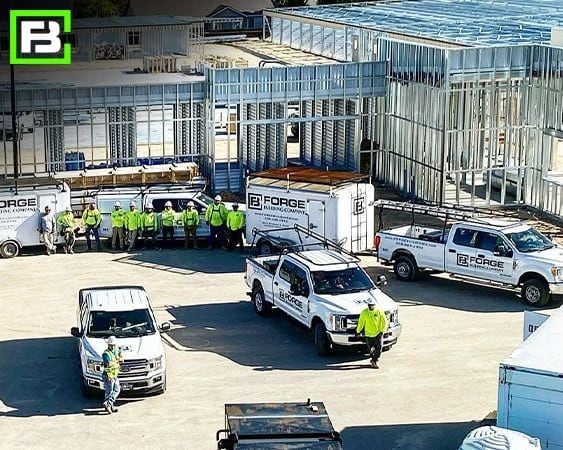 According to this same report, rising expenses such as wages and advertising are impacting the Self-Storage industry.
According to this same report, rising expenses such as wages and advertising are impacting the Self-Storage industry.
There is a lot of competition, especially in a segment that doesn't typically have a lot of amenities to prompt someone to drive farther to get to and feels restricted on how much rent can be raised.
So how do self-storage operators aim to provide a value-add? The Trepp report suggests the following:
The report also suggests remote management – operating a facility without an on-site manager through digital interactions with customers. This operating model could make it more feasible to invest in a small size storage facility in a small market.
Small towns and rural areas are typically not on the radar for big players. This creates a buyer’s market for potential acquisitions. So, this is a great time to look into that steal building construction investment idea.
Adding to the competition, the market continues to be of interest to big players looking for high-quality investments in the ‘recession-resistant’ commercial real estate space. So, for smaller players, the best options might be partnering with other investors in locally owned operations in small markets, or maybe even building your own, using the increasingly robust choice of self-service digital options.
Today it’s possible to build REAL wealth in the Self-Storage industry at a fraction of what it used to cost, meaning the unfair advantages are now available to individuals like you.
To find out more about how to invest in this growing industry, let Forge be your self-storage building contractor partner. See some of our completed projects.
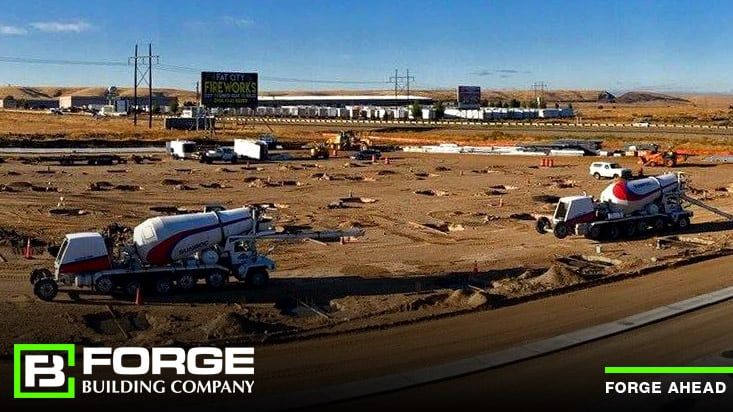 Despite all of the craziness that the pandemic has caused, self-storage development continues its forward momentum—but not without impediments. The cost of raw materials is on the rise, and orders can take longer to ship, plus there are labor shortages. These issues will likely resolve in time, but there’s one obstacle poised to grow still more obtrusive: a lack of suitable sites on which to build. Between market saturation and increasingly restrictive zoning, builders and owners struggle to find suitable parcels to build self storage facilities. It’s a process that’s often taking longer and generating more frustration.
Despite all of the craziness that the pandemic has caused, self-storage development continues its forward momentum—but not without impediments. The cost of raw materials is on the rise, and orders can take longer to ship, plus there are labor shortages. These issues will likely resolve in time, but there’s one obstacle poised to grow still more obtrusive: a lack of suitable sites on which to build. Between market saturation and increasingly restrictive zoning, builders and owners struggle to find suitable parcels to build self storage facilities. It’s a process that’s often taking longer and generating more frustration.
Every self-storage construction project has its own nuances, and it’s never a “one size fits all” when it comes to construction but following are some basic “rules of thumb” to help point you in the right direction.
Additionally, also see our blog post, “Building a Commercial Storage Building” for more insights into understanding development fundamentals.
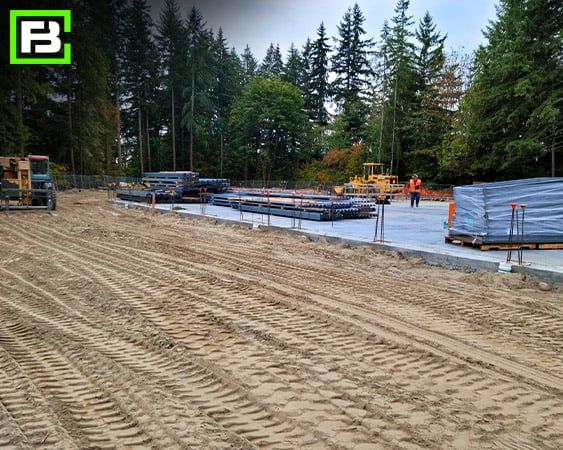
For a sample of the types of single-story self-storage buildings that Forge Building Company offers, please check out: Single-Story Self-Storage Building Contractors
And for more information on costs and location considerations, please see our blog titled “Contractors That Build Commercial Storage Buildings & Facilities.”
Finding a suitable parcel on which to build a self-storage facility with the best steel building contractor will also reap the highest return on investment and get your 2022 off to a great year.

Recent thefts at high-end retailers are a good reminder that the holiday season can bring about more criminal activity. Make sure you are protecting your self-storage business from being vulnerable.
About a month ago, a Nordstrom department store in Walnut Creek, California was ransacked in what police are calling an “organized theft.” Anyone that may have seen the footage, would agree that this was a well-planned, coordinated crime. Around 9 p.m. on a Saturday, the thieves entered the store, grabbed merchandise, and fled to their vehicles, which were conveniently and haphazardly parked just outside the store, crowding the street. Two employees were assaulted, and another was doused with pepper-spray. Some arrests have been made, and police are still investigating.
What’s scary about this whole incident is the possibility that it might not be isolated and how it clearly demonstrates what lengths people are willing to go to get what they want. While this may not happen at a self-storage facility, it’s a great reminder that all and any sort of business is susceptible to theft.
The first thing to think about is, “How’s your security?” Many facilities with video and other security measures are experiencing break-ins. It’s not enough to add security and expect it to insulate your business from crime. You must also look for other creative ways to prevent it every day.
Components that can help include:
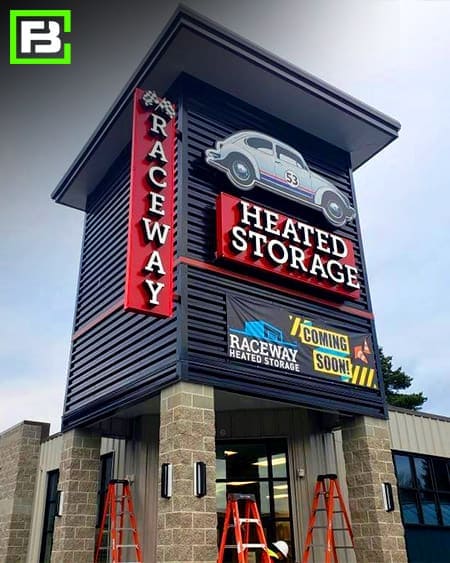 In addition to break-ins, there are a host of other problems that could wreak havoc on your business. Read this blog from a storage operator who dealt with vagrants hanging around and causing damage. Criminal activity increases during this time of year, so be on guard.
In addition to break-ins, there are a host of other problems that could wreak havoc on your business. Read this blog from a storage operator who dealt with vagrants hanging around and causing damage. Criminal activity increases during this time of year, so be on guard.
Besides having a solid security system, it is also important to walk around your property frequently and look for things that might seem out of place. For example, examine unit locks and keypads for tampering and encourage your tenants to report odd behavior or events. Keep an eye on your security cameras as people move about your property. Make yourself present so everyone knows you’re keeping an eye on the facility. For customers of Forge, we do three daily walk-throughs to audit locks and doors and inspect visual signs for any potential problems. We offer This service to our new and existing self-storage customers.
While it is key to keep your facility at a good occupancy level, that doesn’t mean you should ever let your guard down. When someone comes in to lease a unit, make sure you are following all protocols, checking identification and asking questions. Questionable people don’t like questions. They offer vague answers and might not look you in the eye. If their identification doesn’t check out, tell them you can’t accept it and don’t be afraid to say “no.” Self-Storage Talk members often share “dodge a bullet” moments when a prospect seems like trouble, and they refuse the rental.
In truth, it’s been a crazy, disastrous couple of years, and many people are desperate, especially at this time of year. Even those who might’ve never considered crimes before could be entertaining the thought. This person could already be a tenant! Or, someone who just drove by your site and thought it might be good for a burglary. Prospect to walk through your door may be casing your business. Don’t leave your facility vulnerable. Your self-storage site might not be Nordstrom, but it’s just as valuable to you.
 Whether you’re a seasoned veteran or new to the self-storage business, it is key that you learn how to identify and understand your target market using demographics as a tool. The correct use of this date is vital to your facility’s success. As with any real estate business or investment, location is of the utmost importance for a self-storage facility. It’s critical to understand your market, particularly if competitors are closing in.
Whether you’re a seasoned veteran or new to the self-storage business, it is key that you learn how to identify and understand your target market using demographics as a tool. The correct use of this date is vital to your facility’s success. As with any real estate business or investment, location is of the utmost importance for a self-storage facility. It’s critical to understand your market, particularly if competitors are closing in.
Demographics are the statistical data of a population within a defined geographic area. This usually includes population, age of the population, race, housing types, income levels, education levels and more. Knowing these details about your market will help you to make decisions about how to attract and service customers.
Sometimes you find a tract of land that looks good for self-storage. You may have driven around the area and become familiar with all the competitors, watched the traffic flow by the site, feel the price is right, and think local government officials will approve your development plan. When you look at the demographics reports for the area, you may find the region has a very low-density population and a very low-income level per person and household. However, you also may discover the majority of local residents rents their homes, and most of those live in multi-family units such as apartments or mobile-home parks. By doing some shopping, you find out the competitors are all full in their smaller unit sizes, and they’re all comparable in price. Second, you learn there’s sometimes a waiting list for certain unit sizes.
This information would tell me that in spite of the low density, a lot of this population appears to need storage, since the housing units are small, and they’re probably already using storage on a regular basis. The fact that unit prices are all on par indicates that price is important to this market, but there may be an opportunity to get slightly higher rents. The data also indicates that you probably shouldn’t build a “Cadillac” storage center when a mid-priced Chevrolet might work.
This information is, of course, just the beginning of what you would need to decide about whether to build, but it demonstrates how knowing market demographics can be extremely useful.
If you already operate a self-storage facility, and you’re noticing some drops in occupancy, using demographics reports can help you find out information such as:
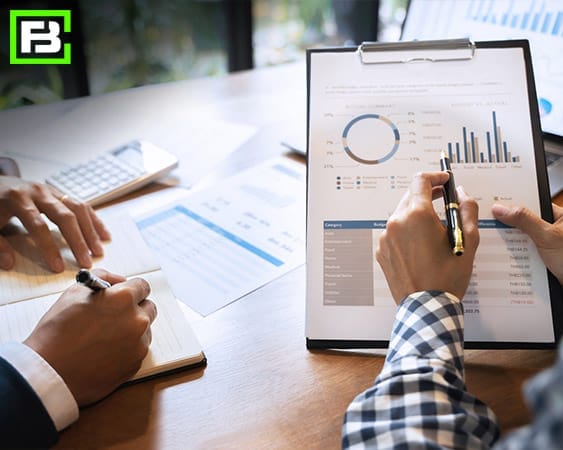 This presents a couple of interesting possibilities. For example, should you create any of your marketing materials in Spanish? What about putting some marketing materials together that show how freeing up room in the garage or carport makes for a less cluttered home and allows the homeowner to enjoy his space? You can even demonstrate how the average household should have some disposable income, since each home is well within the average income level for the area.
This presents a couple of interesting possibilities. For example, should you create any of your marketing materials in Spanish? What about putting some marketing materials together that show how freeing up room in the garage or carport makes for a less cluttered home and allows the homeowner to enjoy his space? You can even demonstrate how the average household should have some disposable income, since each home is well within the average income level for the area.
Using this data, you could also tell you that your market population is somewhat sophisticated and, thus, more prone to have a mobile device or computer. Now your method of advertising delivery can be varied and less costly.
These are just a couple of ways demographic information can be helpful. This information can also be used to determine unit pricing. If you find your area has a higher than average per-capita income level, it would be safe to assume your pricing could be a little higher. Conversely, if you’re having a hard time renting at your asking rates, you might want to look at the income levels in your market and make the appropriate adjustments.
Once you’ve identified your market using demographic data, it can be a useful tool in managing your marketing campaigns, determining which advertising sources to use, adjusting rental rates, predicting the unit types most likely to rent, etc. By knowing your market income levels, housing types, educational levels and more, will make your facility more productive and efficient. The use of demographic data is key to having a successful self-storage facility, whether it’s new to the market or well-established.
When you are ready to build or modify your self-storage facility, the team at Forge Building Company can help you achieve your goals. Give us a call to discuss your project.
To view our some of our recent project, see https://forgebuildings.com/projects/